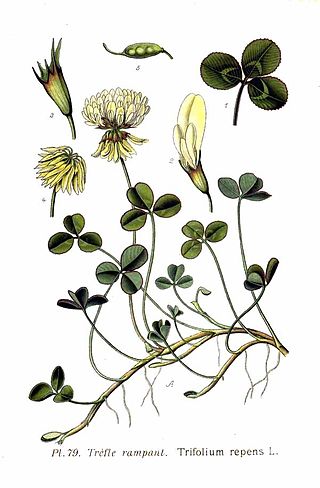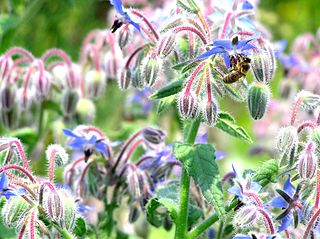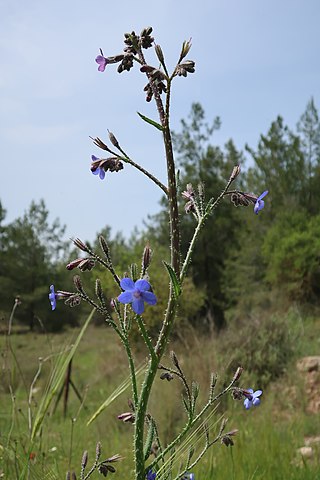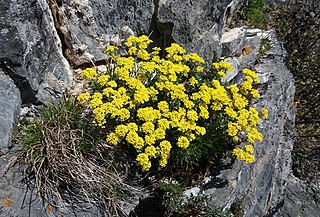
Clover, also called trefoil, are plants of the genus Trifolium, consisting of about 300 species of flowering plants in the legume family Fabaceae originating in Europe. The genus has a cosmopolitan distribution with highest diversity in the temperate Northern Hemisphere, but many species also occur in South America and Africa, including at high altitudes on mountains in the tropics. They are small annual, biennial, or short-lived perennial herbaceous plants, typically growing up to 30 centimetres (12 in) tall. The leaves are trifoliate, with stipules adnate to the leaf-stalk, and heads or dense spikes of small red, purple, white, or yellow flowers; the small, few-seeded pods are enclosed in the calyx. Other closely related genera often called clovers include Melilotus and Medicago.

Boraginaceae, the borage or forget-me-notfamily, includes about 2,000 species of shrubs, trees, and herbs in 146 to 156 genera with a worldwide distribution.

Nonea is a genus of flowering plants in the family Boraginaceae. Sometimes known as monkswort, these are herbaceous perennials or annual plants, native to Europe, Asia and Africa.

Myosotis is a genus of flowering plants in the family Boraginaceae. The name comes from the Ancient Greek μυοσωτίς "mouse's ear", which the foliage is thought to resemble. In the Northern Hemisphere, they are colloquially known as forget-me-nots or scorpion grasses. Myosotis alpestris is the official flower of Alaska and Dalsland, Sweden. Plants of the genus are commonly confused with Chatham Islands' forget-me-nots, which belong to the related genus Myosotidium.

Borago, or borage, is a genus of five species of herbs native to the Mediterranean, with one species, Borago officinalis, cultivated and naturalized throughout the world.

Anthemis is a genus of aromatic flowering plants in the family Asteraceae, closely related to Chamaemelum, and like that genus, known by the common name chamomile; some species are also called dog-fennel or mayweed. Anthemis are native to the Mediterranean region and southwest Asia east to Iran. A number of species have also become naturalized in the United Kingdom and other parts of the world.

Cynoglossum is a genus of small-flowered plants in the family Boraginaceae.

Euphrasia, or eyebright, is a genus of about 450 species of herbaceous flowering plants in the family Orobanchaceae, with a cosmopolitan distribution. They are hemiparasitic on grasses and other plants. The common name refers to the plant's use in treating eye infections.
Bugloss is a name used for several plants in the borage family (Boraginaceae):
Alkanet is the common name of several related plants in the borage family (Boraginaceae):

Boraginoideae is a subfamily of the plant family Boraginaceae s.s, with about 42 genera. That family is defined in a much broader sense in the Angiosperm Phylogeny Group (APG) system of classification for flowering plants. The APG has not specified any subfamilial structure within Boraginaceae s.l.

Subgenus Iris is one subgenus of Iris.

Iris notha is a species in the genus Iris, it is also in the subgenus Limniris and series Spuriae. It is a rhizomatous perennial with deep blue or violet flowers from the Caucasus region. It is cultivated as an ornamental plant in temperate regions. It was once Iris spuria subsp. notha, and can often be found under that name. It has the common name of fake iris or mimic iris in Russia.
The precise taxonomy of the genus Allium is still poorly understood with incorrect descriptions being widespread. With over 850 species distributed over the Northern hemisphere Allium is the sole genus in the Allieae, one of four tribes of subfamily Allioideae (Amaryllidaceae). New species continue to be described and Allium is both highly variable and one of the largest monocotyledonous genera, but the precise taxonomy of Allium is poorly understood, with incorrect descriptions being widespread. The difficulties arise from the fact that the genus displays considerable polymorphism and has adapted to a wide variety of habitats. Furthermore, traditional classications had been based on homoplasious characteristics. However, the genus has been shown to be monophyletic, containing three major clades, although some proposed subgenera are not. Some progress is being made using molecular phylogenetic methods, and the internal transcribed spacer (ITS) region, including the 5.8S rDNA and the two spacers ITS1 and ITS2, is one of the more commonly used markers in the study of the differentiation of the Allium species.

Hormuzakia aggregata is a flowering annual plant in the Borage family, known by the common name massed alkanet.

Anchusa strigosa is a non-succulent species of herbaceous plants in the Boraginaceae family endemic to the Eastern Mediterranean regions, particularly, Greece, Turkey, Lebanon, Israel, Jordan, and Iran. It is known widely by its common names of strigose bugloss and prickly alkanet.

Anchusa capensis, is a species of flowering plant in the family Boraginaceae, native to Namibia, South Africa and Lesotho. The genus Anchusa is from the Greek word anchousa, which makes reference to its use as a dye base for cosmetic paint obtained from the roots of another plant in the genus Anchusa tinctoria. The species capensis translates to ‘from the Cape’ referring to South Africa

Odontarrhena is a large genus of flowering plants in the family Brassicaceae. They were originally a separate genus and then were amalgamated into the Alyssum genus, but then morphological and molecular evidence has reseperated them. Some of the genera are nickel (Ni) hyperaccumulators.















